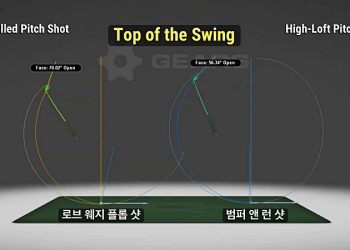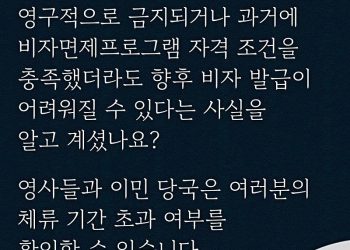숏 아이언 샷에서 역회전(백스핀)을 만들기 위해서는 스윙의 기술적 원리, 장비, 그리고 관련된 물리학의 이해가 필요하다.
기본적으로는 가파르게 내려치는 임팩트가 있어야 한다. 이때 클럽 헤드가 잔디보다 먼저 볼을 치는 것이 중요하다. 내려치는 어택 앵글이 있어야 볼을 지면에 압축시킬 수 있고 볼의 스핀에 필요한 마찰을 만들 수 있기 때문이다. 이상적인 스윙 궤도의 최저점은 임팩트 직후가 되어야 한다. 볼을 친 후의 스윙의 최저점은 10cm 전후로 길게 가져가야 한다.
숏 아이언 샷의 백스핀율은 보통 분당 7,000에서 10,000 사이의 회전을 필요로 한다. 높은 스핀율은 더 많은 백스핀과 그린 위에서 더 나은 볼 컨트롤을 만들 수 있다. 볼 런치 각은 20도에서 30도 사이에서 만들어진다. 발사각을 약간 더 높게 해야 백스핀을 많이 만들 수 있다.
볼 스피드와 백스핀은 연관이 있다. 숏 아이언 샷의 경우 90에서 120mph (mile per hour) 사이다. 적절한 스핀율과결합한 높은 볼 스피드는 뚜렷한 백스핀 효과를 낼 수 있다.
숏 아이언의 어택 앵글은 -3도에서 -7도로 나타난다. 어택 앵글의 각도가 적당히 클수록 백스핀을 많이 만들어 낼 수 있다.
또 중요한 요소는 임팩트 시 클럽의 실제 로프트 각이 높아야 한다는 점이다. 이러한 각도를 다이내믹 로프트라 한다. 일반적으로 9번 아이언의 로프트 각은 41도 전후다. 임팩트 순간에 백스핀을 만들어 내기 위한 다이내믹 로프트는 44도 전후로 각도를 변화시켜야 한다.
그리고 클럽 스피드보다 볼 스피드가 커야 스핀량을 높일 수 있다. 이것을 비율로 나타낸 것이 스매시 팩터다. 숏 아이언의 경우 1.2에서 1.3 정도로 나타난다. 스매시 팩터가 높다는 것은 효율적으로 에너지 전달이 잘 되었다고 볼 수 있다. 이상 설명한 내용을 기본으로 실제 샷을 하는 과정은 다음과 같다.
볼 위치는 일반적으로 중앙에 놓이도록 한다. 중앙보다 왼쪽이면 스핀량은증가시키지만 거리는 줄어들 수 있다. 볼 위치가 중심보다 오른쪽에 놓이면 스핀량은 상대적으로 작아지지만 거리를 만들 수 있다.
볼 위치는 골퍼의 다운스윙 어택 앵글과 관련이 있어서 여러 번의 스윙을 통해 스핀량과 거리의 최대값을 찾을 필요가 있다. 체중을 왼발(오른손잡이 기준) 쪽에 치우치게 하면 클럽의 어택 앵글을 안정적으로 가져갈 수 있다. 손목 위치를 약간 세워 클럽 페이스가 조금 더 누워있는 느낌을 가질 필요가 있다.
백스윙 시 코킹을 확실히 완성시켜야 한다. 숏 아이언 샷의 경우 3/4 스윙으로도 충분히 백스핀을 만들 수 있다. 백스윙 시 하체의 회전을 최소화시켜 몸을 최대한 코일 상태가 되도록 해야 한다.
다운스윙 시 헤드 스피드는 점차적으로 스피드가 늘어나는 가속도의 개념이 필요하다. 임팩트 순간 빠른 손목 릴리스는 백스핀 형성에 도움이 된다. 임팩트 이후에도 그립은 계속 헤드보다 앞쪽에 놓이도록 하면 최대 스핀량을 만드는 데 추가적인 도움이 된다.
임팩트 이후에 진행되는 팔로우 스루는 길지 않게 가져간다. 짧게 끊는다는 느낌으로 마무리하면 효과적이다. 왼쪽에 놓인 체중이 피니시로 이동되면서도 변함없이 왼쪽에 놓이도록 한다.
결과적으로 이러한 스윙의 과정은 볼의 스핀 로프트를 크게 하기 위한 것이다. 스핀 로프트가 클수록 백스핀이 많이 발생한다. 다이내믹 로프트와 어택 앵글의 차이에서 나타나는데 개인의 특성에 맞게 여러 변수를 적용해 가면서 가장 효율적인 데이터를 찾을 필요가 있다.
☞ 전욱휴는…
서울대 졸업 후 미국에 유학, 1996년 PGA 클래스A 프로가 됐다. 이후 28년만인 2024년 전세계 골프계 최고 권위의 ‘PGA 마스터 프로페셔널’ 자격을 획득했다. SBS, MBC, JTBC, YTN 등의 골프 채널 진행자 및 해설자로 활약했고, 지금은 애틀랜타와 한국을 오가며 골프 레슨 및 골프 관련 비즈니스를 하고 있다. chungolf@gmail.com
[Dr.Eric Chun’s Golf Lesson] 35. The Art and Science of Backspin in Short Iron Shots
Generating backspin on short iron shots in golf requires a sophisticated understanding of swing mechanics, equipment characteristics, and the underlying physics. The fundamental principle involves creating a steep, descending blow at impact. It is crucial that the clubhead strikes the ball before contacting the turf. A descending attack angle is necessary to compress the ball against the ground, generating the friction required for spin. Ideally, the lowest point of the swing arc should occur just after impact, with the swing’s nadir extending approximately 10 cm beyond the ball strike.
The spin rate for short iron shots typically ranges from 7,000 to 10,000 revolutions per minute. Higher spin rates generally produce more backspin and superior ball control on the green. The launch angle for short irons is typically between 20 and 30 degrees, with slightly higher launch angles facilitating increased backspin generation.
Ball speed and backspin are intrinsically linked. For short iron shots, ball speeds typically range from 90 to 120 mph. The combination of appropriate spin rate and high ball speed can produce pronounced backspin effects. The attack angle for short irons usually falls between -3 and -7 degrees, with moderately steeper angles generally producing more backspin.
Another critical factor is the club’s effective loft at impact, known as dynamic loft. While a 9-iron typically has a static loft of around 41 degrees, the dynamic loft at impact should be increased to approximately 44 degrees to maximize backspin generation.
Moreover, the ball speed must exceed the clubhead speed to increase spin. This relationship is quantified by the smash factor, which for short irons typically ranges from 1.2 to 1.3. A higher smash factor indicates more efficient energy transfer from club to ball.
Applying these principles in practice involves several key considerations:
Ball position is generally centered in the stance. Positioning the ball slightly left of center can increase spin but may reduce distance, while a right-of-center position can decrease spin but potentially increase distance. Optimal ball position varies based on the golfer’s downswing attack angle and requires experimentation to maximize both spin and distance. Weight should be shifted towards the left foot (for right-handed golfers) to stabilize the attack angle. The wrists should be slightly elevated to promote a more laid-back club face position.
During the backswing, a full wrist cock is essential. For short iron shots, a three-quarter swing is often sufficient to generate ample backspin. Lower body rotation should be minimized to maximize the coiling of the upper body.
The downswing should exhibit a gradual acceleration, with clubhead speed peaking at impact. A quick wrist release at impact aids in backspin generation. Maintaining the grip ahead of the clubhead through and beyond impact can further enhance spin production.
The follow-through should be relatively abbreviated, with an abrupt finish often proving effective. Body weight, initially positioned on the left side, should remain there throughout the finish.
Ultimately, this swing process aims to maximize the ball’s spin loft, which is the primary determinant of backspin. Spin loft is the difference between dynamic loft and attack angle at impact. Golfers should experiment with various parameters to find the most efficient combination for their individual swing characteristics, optimizing their ability to generate and control backspin with short irons.
By Dr.Eric Chun,PGA Master Professional





![[전욱휴의 골프레슨] 35. 숏 아이언 샷 백스핀](https://www.atlantajoongang.com/wp-content/uploads/2024/11/Zzcollage-750x469.jpg)













![[전욱휴의 골프 레슨] 46. 배치기(얼리 익스텐션)](https://www.atlantajoongang.com/wp-content/uploads/2025/03/photoKakaoTalk_20250306_073237889_01-350x250.jpg?v=1741361116)
![[전욱휴의 골프 레슨] 45. 임성재 '행온페이드' 샷](https://www.atlantajoongang.com/wp-content/uploads/2025/02/collage1-350x250.jpg)
![[전욱휴의 골프레슨] 44. 일관된 샷을 원한다면](https://www.atlantajoongang.com/wp-content/uploads/2025/02/QKakaoTalk_20250212_065748485-350x250.jpg)

![[전욱휴 골프 레슨] 42. 오른쪽 팔꿈치 역할](https://www.atlantajoongang.com/wp-content/uploads/2025/01/qQ1KakaoTalk_20250130_072058648-350x250.jpg)
![[전욱휴의 골프 레슨] 41. 매킬로이 파워 스윙](https://www.atlantajoongang.com/wp-content/uploads/2025/01/qQ1KakaoTalk_20250122_123635940-350x250.jpg)







